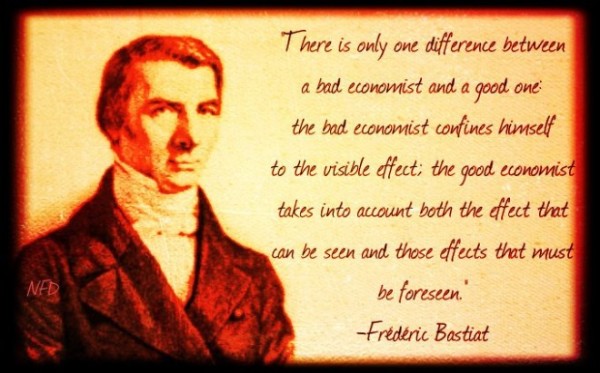Anybody who understands Bastiat’s example of the broken window fallacy understands more about life than most academics.
French economist Frédéric Bastiat, a classical economist who heavily influenced the austrian school of thinking, released an economic essay in 1850 titled “Ce qu’on voit et ce qu’on ne voit pas” or “That Which We Do Not See“.

Bastiat’s work here laid the ground work, in my mind, for how we conceptualize the ripple effects of economic activity. If you are unfamiliar with the broken window fallacy, it can be summed up quite simply:
A child is playing with his baseball, and accidentally sends it through his neighbor’s window. The neighbor must then call up the window repairman to come out and install new glass. This act of breaking the window, stimulates economic activity. The glass maker now has business which we would not have had before, and profits.
Now at a glance, this statement seems true, that is, it seems true provided we only examine the immediately visible effects of this event. However, if we take a step back from the immediate activity of the broken window and its repair, we can begin to think like an economist.
The neighbor (let’s call him Stan) has an opportunity cost of capital for what he must now use to have his window repaired. Assuming Stan can even afford the replacement window, now that capital which he could’ve used for other purposes, must be used to fix the window. Had the window not been broken, Stan could’ve spent that money on any number of things.
He could’ve chosen to buy some new clothes, he could’ve taken his wife out to dinner, he may have even invested it in his business. But all of this economic activity now cannot happen, because the capital which Stan might have used for his own purposes, now must be consumed to repair his window.
In order for Stan to have the money to replace the window, it means he must’ve deferred some amount of his consumption in the past to save that money. Had he been given the option, Stan (and any rational actor) would’ve rather spent that money on something he desired yesterday, than on the unforseen which he did not desire today,
It is common, for economists of the academic variety to miss these second and third and fourth and fifth order effects of economic action. It is taxes, government spending, and wars which drive economic growth, they say. By collecting and redistributing capital to what government administrations deem necessary, they are stimulating economic growth.

But we know this to be untrue. We know that economic actors are individuals. Each with their own preferences that can change at any one moment in time. A centralized power can never have the adequate information to substitute this action of the individual, and produce the same or better economic activity. Governments direct capital towards what individuals in those governments deem to be important. Individual economic actors direct capital towards what those individuals deem to be important.
Individual human action is the primary driver of all economic activity. The redistribution of capital, carries with it an opportunity cost, that denies the allocation of resources to that which the market most desires. Expansionary monetary policy, which by design must redistribute capital, can only be a net positive force through the lens of one who does not understand the words of Bastiat.
